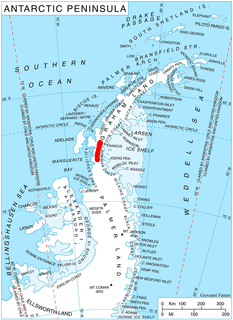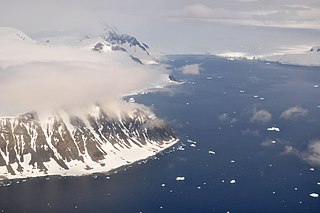
Alexandra Mountains is a group of low, separated mountains in the north portion of Edward VII Peninsula, just southwest of Sulzberger Bay in Marie Byrd Land, Antarctica. Discovered in January–February 1902 by the British National Antarctic Expedition during an exploratory cruise of the Discovery along the Ross Ice Shelf. Named for Alexandra, then Queen of the United Kingdom.

The Prince Charles Mountains are a major group of mountains in Mac. Robertson Land in Antarctica, including the Athos Range, the Porthos Range, and the Aramis Range. The highest peak is Mount Menzies. Other prominent peaks are Mount Izabelle and Mount Stinear. These mountains together with other scattered peaks form an arc about 260 miles long, extending from the vicinity of Mount Starlight in the north to Goodspeed Nunataks in the south.
Quervain Peak is a peak in the central part of the Boyle Mountains in Graham Land, Antarctica. Mapped by Falkland Islands Dependencies Survey (FIDS) from surveys and air photos, 1956–59, it was named by the United Kingdom Antarctic Place-Names Committee (UK-APC) for Alfred de Quervain, a Swiss glaciologist who in 1909 first applied photogrammetric methods to the measurement of surface glacier flow.
Sharp Glacier is a glacier flowing north to the head of Lallemand Fjord, close east of the Boyle Mountains, in Graham Land. Mapped by Falkland Islands Dependencies Survey (FIDS) from surveys and air photos, 1948-59. Named by United Kingdom Antarctic Place-Names Committee (UK-APC) for Robert P. Sharp, American geologist who has undertaken numerous studies on glaciers and their flow.

Haefeli Glacier is a glacier, 2 miles (3 km) wide and 6 miles (10 km) long, situated on Pernik Peninsula, Loubet Coast in Graham Land, Antarctica, at the northwest side of Finsterwalder Glacier and flowing south-southwest toward the head of Lallemand Fjord. With Finsterwalder and Klebelsberg Glaciers, its mouth merges with Sharp Glacier where the latter enters the fjord. It was first surveyed in 1946–47 by the Falkland Islands Dependencies Survey and named by them for Robert Haefeli, a Swiss glaciologist.

Finsterwalder Glacier is a glacier on the northwest side of Hemimont Plateau, 2 nautical miles wide and 10 nautical miles long, flowing southwest from the central plateau of Graham Land, Antarctica, toward the head of Lallemand Fjord. Its mouth lies between the mouths of Haefeli Glacier and Klebelsberg Glacier, the three glaciers merging with Sharp Glacier where the latter enters the fjord. It was first surveyed from the plateau in 1946–47 by the Falkland Islands Dependencies Survey, and named by them for Sebastian Finsterwalder and his son, Richard Finsterwalder, German glaciologists.

Antevs Glacier, also known as North Heim Glacier, is a glacier on Arrowsmith Peninsula, Graham Land, flowing north between Seue Peaks and Boyle Mountains into Muller Ice Shelf, Lallemand Fjord. It was named by the United Kingdom Antarctic Place-Names Committee in 1960 after Ernst V. Antevs, American glacial geologist.

Bader Glacier is a small glacier draining the west slopes of Rudozem Heights and flowing to Bourgeois Fjord just south of Thomson Head on German Peninsula, Fallières Coast on the west side of Graham Land, Antarctica. It was named by the UK Antarctic Place-Names Committee in 1958 for Swiss glaciologist Henri Bader of Rutgers University (U.S.), author of an important thesis on the development of the snowflake and its metamorphoses.
Bartholin Peak is a conspicuous peak near the north end of the Boyle Mountains in Graham Land. It was named by the UK Antarctic Place-Names Committee in 1958 for Erasmus Bartholin, of Copenhagen, whose De Figura Nivis Dissertatio, 1661, includes the earliest known scientific description of snow crystals.
Mount Cadbury is the easternmost of the Batterbee Mountains, 1,800 metres (5,900 ft) high, standing east-southeast of Mount Ness and 18 nautical miles (33 km) inland from George VI Sound on the west coast of Palmer Land. The coast in this vicinity was first seen and photographed from the air on November 23, 1935 by Lincoln Ellsworth, but this mountain seems to have been obscured from Ellsworth's line of sight by clouds or intervening summits. Mount Cadbury was surveyed in 1936 by the British Graham Land Expedition (BGLE) under John Rymill, and named by the UK Antarctic Place-Names Committee in 1954 for Mrs. Henry Tyler Cadbury, who raised a special fund to defray the cost of refitting the Penola, the ship of the BGLE, at South Georgia in 1936.

Stonehouse Bay is a bay in Antarctica on the west side of Laubeuf Fjord, indenting the east coast of Adelaide Island between Hunt Peak and Sighing Peak. The bay is 5 nautical miles (9 km) wide. It was first sighted and surveyed in January 1909 by the French Antarctic Expedition under Jean-Baptiste Charcot. The bay was named for Bernard Stonehouse of the Falkland Islands Dependencies Survey (FIDS), a meteorologist in 1947-48 and biologist in 1949 at Stonington Island and leader of the FIDS sledge party which resurveyed the bay in 1948.

Field Glacier is a glacier on Pernik Peninsula, Loubet Coast in Graham Land, situated south of Salmon Cove, and flowing west into Lallemand Fjord just south of Kanchov Peak. It was mapped from air photos taken by the Falkland Islands and Dependencies Aerial Survey Expedition, 1956–57. In association with the names of glaciologists grouped in this area, it was named by the UK Antarctic Place-Names Committee after William B.O. Field, an American glaciologist and surveyor, sometime Research Fellow of the American Geographical Society.
Lliboutry Glacier is a glacier flowing southwest from the Boyle Mountains of Antarctica into Bourgeois Fjord, Loubet Coast. It was named by the UK Antarctic Place-Names Committee in 1983 after Louis A.F. Lliboutry, a French physicist and glaciologist who investigated the mechanical deformation of ice and the micro-meteorological properties of ice surfaces, and who also made a general study of glaciers in the Antarctic Peninsula. Lliboutry was Director of the Laboratory of Glaciology, University of Grenoble, 1958–83, and President of the International Commission on Snow and Ice, 1983–87.
Heim Glacier is a glacier 8 nautical miles (15 km) long in the southeast part of Arrowsmith Peninsula, which flows south to merge with the ice in Jones Channel on the west coast of Graham Land, Antarctica. With Antevs Glacier to the north, it forms a transverse depression extending to the southwest part of Lallemand Fjord. Heim Glacier was first sighted from the air in 1936 by the British Graham Land Expedition under John Rymill. Its lower reaches were surveyed in 1949 by the Falkland Islands Dependencies Survey, and the glacier named by them for Albert Heim, a Swiss glaciologist and the author in 1885 of Handbuch der Gletscherkunde.

Tammann Peaks are peaks on Pernik Peninsula, Loubet Coast in Graham Land, standing 4 nautical miles (7 km) southeast of Orford Cliff and a like distance east of Lallemand Fjord. Mapped from air photos taken by Falkland Islands and Dependencies Aerial Survey Expedition (FIDASE) (1956–57). Named by United Kingdom Antarctic Place-Names Committee (UK-APC) for Gustav H.J.A. Tammann, German physical chemist who (1900–1935) made important studies of the physical properties of ice.

Klebelsberg Glacier is a glacier, 7 nautical miles (13 km) long and 2 nautical miles (4 km) wide, situated at the south side of Finsterwalder Glacier and flowing from Hemimont Plateau northwestward between Armula Peak and Smilyan Bastion on Graham Land, Antarctica, toward the head of Lallemand Fjord. With Finsterwalder Glacier and Haefeli Glacier, its mouth merges with Sharp Glacier where the latter enters the fjord. It was first surveyed from the plateau in 1946–47 by the Falkland Islands Dependencies Survey, and named by them for Raimund von Klebelsberg, an Austrian glaciologist.

McCall Point is a point on the east side of Lallemand Fjord, 4 nautical miles (7 km) northwest of Salmon Cove on the west coast of Pernik Peninsula, on the Loubet Coast of Graham Land, Antarctica. It was mapped from air photos taken by the Falkland Islands and Dependencies Aerial Survey Expedition, 1956–57, and was named by the UK Antarctic Place-Names Committee after American engineer John G. McCall (1923–54) of the University of Alaska, who first measured the detailed internal movement of a cirque glacier in 1951–52.

Sölch Glacier is a glacier on the Pernik Peninsula of the Loubet Coast in Graham Land, flowing west to Salmon Cove just north of Kanchov Peak on the east side of Lallemand Fjord. It was mapped from air photos taken by the Falkland Islands and Dependencies Aerial Survey Expedition, 1956–57, and named by United Kingdom Antarctic Place-Names Committee for Johann Sölch (1883–1951), an Austrian glacial geologist and glaciologist.
Richter Peaks is a group of peaks rising to about 1,385 m located near the southern extremity of the Walton Mountains, situated in the central portion of Alexander Island, Antarctica. The peaks were named by Advisory Committee on Antarctic Names for Joseph J. Richter, United States Antarctic Research Program biologist, Palmer Station, 1965–66 and 1966-67.

Rudozem Heights are the heights rising to 1500 m at the base and in the interior of German Peninsula on Fallières Coast in Graham Land, Antarctica, extending 18.5 km in northeast-southwest direction and 13.7 km in east-west direction. The heights are bounded by Bourgeois Fjord to the north and west, Dogs Leg Fjord to the south, and to the east by a glacier draining both northwards into Bourgeois Fjord and southwards into Dogs Leg Fjord.










